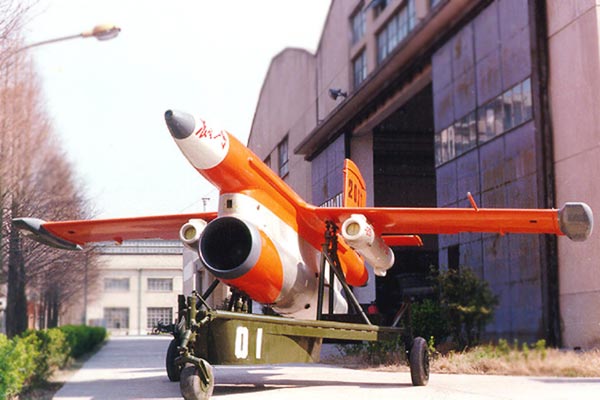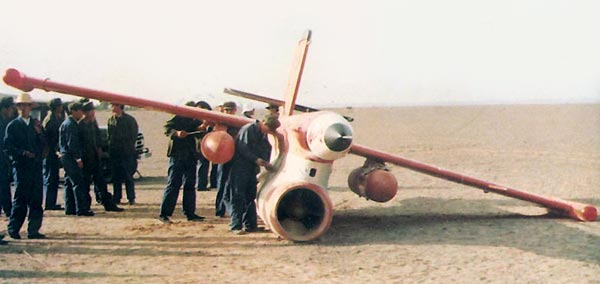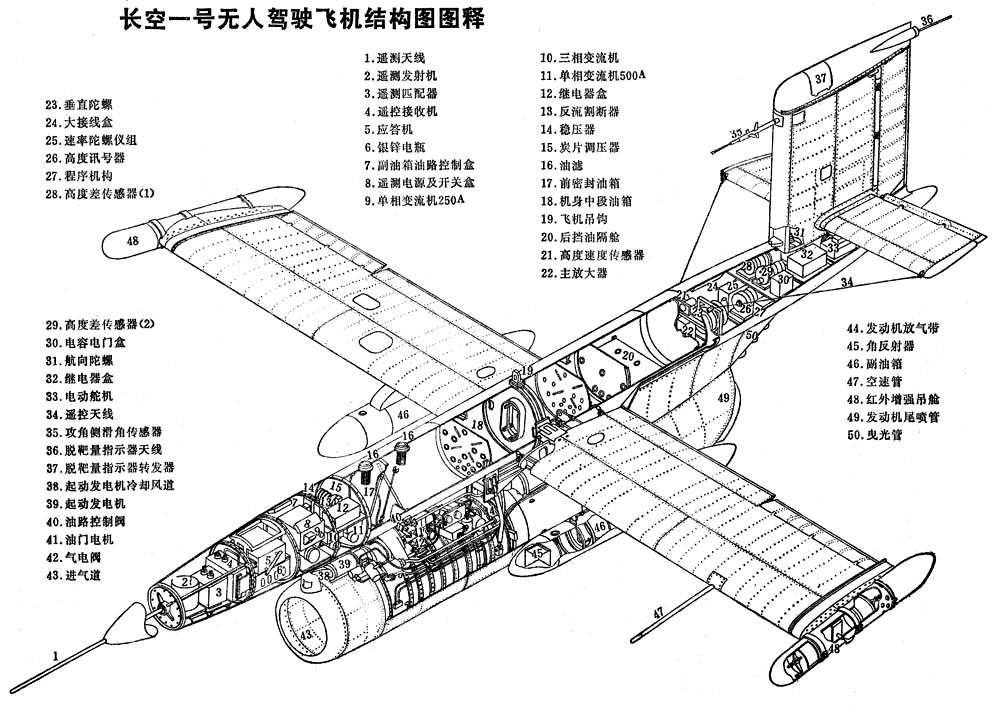| ChangKong-1 Unmanned Aerial Vehicle / Target Drone
中国长空-1型无人机/靶机 Date:2010-02-22 Source:internet By:globalmil Viewed: |

The ChangKong-1 is a radio-controlled , jet-powered subsonic unmanned aerial vehicle developed from the Soviet Lavochkin La-17C. Developed by Nanjing Institute of Aeronautics in the late 1960s, the ChangKong-1 has been in serving with the PLAAF since the late 1970s for target drone and nuclear air sampling roles.
长空(ChangKong)-1是一种无线电-控制、喷气动力亚音速无人机基于苏联Lavochkin La-17C型发展。在1960年后期由南京航空学院发展,长空-1型从1970年后期以后在PLAAF服役用于靶机和核空气取样任务。
The PRC obtained a small number of the Lavochkin La-17 radio-controlled, ramjet-powered target drone from the Soviet Union in the late 1950s. These drones were being sued for airborne- and air-defence weapon testing and practicing. Acquisition of additional units was unsuccessful due to Moscow’s decision in 1960 to stop all of its technical aids to the PRC. This forced the PLA to develop its own indigenous target drone ChangKong-1.
在1950年后期中国从苏联获得了少量Lavochkin La-17型无线电-控制,喷气动力靶机。这些无人机用于机载-和防空武器测试和练习。另外的单位在1960年由于莫斯科决定停止对中国所有它的技术帮助而无法获得。这迫使PLA发展本国的靶机长空-1型。
The ChangKong-1 project began in the early 1960s, with the development work carried out by the PLAAF Weapon Test & Training Base. The chief designer of the programme is General Zhao Xu, who is known as ‘the Father of Chinese UAV’. Several La-17C examples were dissembled by Chinese engineers for study and reverse engineering. Because of the PRC’s incapability to produce a suitable ramjet engine, the indigenous target drone was powered by a Wopen-6 (WP-6) turbojet engine originally developed for the Shenyang J-6 (MiG-19 Farmer) fighter.
长空-1型计划在1960年早期开始,由PLAAF武器测试和训练基地进行发展工作。计划的设计总负责人是中国工程院院士赵煦将军,也被誉为‘中国无人机之父’。一些La-17C型样机是为研究和反向工程被中国工程师掩饰。因为中国没有能力生产一种合适的冲压式喷气发动机,国产靶机动力由一台涡喷-6(WP-6)涡喷发动机提供,最初用于沈飞J-6(米格-19“农夫”)战斗机。
The ChangKong-1 successfully flew in December 1966, but the development programme was severely disrupted by the political impact of the ‘Culture Revolution’ in the 1960s~70s. The ChangKong-1 development was resumed by Nanjing Institute of Aeronautics (now Nanjing University of Aeronautics & Astronautics, NUAA) in the 1970s and the development did not finish until 1976, eight years after the project began. The ChangKong-1 entered PLAAF service in the late 1970s for weapon testing and air defence training.
长空-1成功地在1966年12月飞行,但是发展计划由于某些原因在1960年~70年受到干扰。在1970年长空-1发展被南京航空学院重新开始(现在南京航空航天大学,NUAA)和发展直到1976年前没有完成,这已经在计划开始8年之后。在1970年后期长空-1型用于武器测试和防空训练进入PLAAF服役。
Variants
改型
ChangKong-1A Nuclear Air Sampling UAV
The nuclear air sampling variant ChangKong-1A was first deployed in Lop Nor nuclear test site in 1978, ending the history of using manned aircraft for air sampling missions in China’s nuclear tests.
长空-1A型核空气取样UAV
核空气取样型长空-1A在1978年罗布泊核试爆地点被首次部署,结束使用有人操纵飞机执行中国核试爆空气取样任务的历史。
ChangKong-1B/C/E Target Drone
A number of improved variants have been introduced, including the ChangKong-1B low-altitude target drone, the ChangKong-1C High-manoeuvrability target drone, and the ChangKong-1E ultra-low-altitude target drone.
长空-1B/C/E型靶机
许多的改型已经被推出,包括长空-1B低空靶机、长空-1C高机动性靶机和长空-1E超低空靶机。
ChangKong-2
The ChangKong-2 supersonic target drone was derived from the ChangKong-1. The CK-2 programme began in the early 1990s in response to the PLAAF’s requirement for a supersonic target drone to test its new generation air-to-air missile. No detailed information on the CK-2 is available, but it is understood that the drone first flew in the early 1990s, and its first successful supersonic flight took place in early 1995. The drone features a digital flight control, which was seen as a major breakthrough in China's UAV technology.
长空-2型
长空-2超音速靶机起源于长空-1型。CK-2计划在1990年早期开始响应PLAAF需求一种超音速靶机测试它的新一代空对空导弹。没有关于CK-2型可得的详细资料,但是一般了解无人机在1990年早期首次飞行,而且它的第一次成功的超音速飞行在1995年早期。无人机以飞行数控为特点,被视为中国UAV技术的一次主要的突破性发展。
Design
The ChangKong-1 is generally similar to the La-17 in appearance. The UAV has a slim, round fuselage with a sharp nose. The wings, vertical fin and tails are all square-shape. A WP-6 turbojet engine is mounted under the fuselage. The mission payloads are carried on the two under-wing pylons. The UAV is controlled by autopilot and radio command.
设计
长空-1型一般在外表上与La-17型类似。UAV有一个细长,采用尖鼻的圆形机身。机翼、垂直尾翼和尾部全部是距形。一台WP-6涡喷射发动机安装在机身下。任务负载在二个机翼下挂架上携带。UAV由自动驾驶仪和无线电指令控制。
Launch / Recovery
Unlike the La-17, which is carried and released by the carrier aircraft in the midair, the ChangKong-1 uses a unique ‘skateboard’ system to takeoff from ground directly. The drone is mounted on an un-powered three-wheel glide, which performs as the landing gear during the takeoff. Once the drone approaches the takeoff speed on the runway, the glide is separated from the drone and slowed down by a break chute. Early variants ChangKong-1s were only powered by the WP-6 turbojet engine during the takeoff, and therefore required a fairly long runway to generate enough speed. The later variants are accelerated by rocket boosters and only require a short runway for takeoff.
发射/回收
不像La-17型,被运输机携带和在半空中释放,长空-1使用一种独特的‘滑板'系统直接从地面起飞。无人机装在一辆无动力三轮滑车上,在起飞时作用如同起落架。一但无人机在跑道上接近起飞速度, 滑板与无人机分离而且被一个制动伞减速。早期型长空-1型在起飞期间仅仅被一台WP-6涡喷发动机提供动力,因此需要一条相当长的跑道产生足够的速度。后期型号由火箭助推器加速并且只需要短跑道用于起飞。

Since the ChangKong-1 was originally designed as a target drone, the recovering was not a primary concern in its design. However, to reduce the cost if the drone was missed by the weapon, as well as the requirement for other missions such as air sampling and aerial photography, the drone could be recovered by a guided belly-landing, which requires certain repair before it can fly again. Later variants of the ChangKong-1 might be capable of parachute recovering.
既然长空-1型本来被设计当作一种靶机,回收不是它的设计主要关心的方面。然而,减少成本如果无人机被武器脱靶和需要用于其它的任务,像是空气取样和航空摄影,无人机能以引导机腹着陆方式回收,在它再一次能飞行之前需要修理。稍后型号的长空-1能能够采用降落伞回收。
Mission Payload
The mission equipment onboard the ChangKong-1 includes five passive radar reflectors, four HaiYing light reflecting missiles, and wingtip-mounted infrared equipment pods.
任务负载
长空-1型机载任务设备包括五部被动式雷达回波角反射器,四枚海鹰(HaiYing)曳光弹和
翼尖装红外设备吊舱。
Powerplant
The ChangKong-1 is powered by a WP-6 turbojet, rated at 24.5 kN. The fuel capacity is 600kg (820 litre volume). The models B and C can increase capacity to 820kg with fuel pods.
动力装置
长空-1型由一台WP-6涡喷发动机提供动力,额定24.5 kN。燃料能力600公斤(820公升容积)。B和C型能够增加燃料舱能力到820公斤。
Specifications
Dimentions: Wingspan 7.5m; Length 8.435m; Height 2.955m
Weight: Empty 2,000~2,500kg; Fuel 600~840kg
Speed: 850~900km/h
Range: 600km
Flight endurance: 70min (low level); or 45~60min (high-level)
Service ceiling: 10,000~18,000m
Operational altitude: 500 ~ 5000m
规格
尺寸: 翼展 7.5 米;机长 8.435 米;机高 2.955 米
重量: 空重 2,000~2,500 公斤;燃料 600~840 公斤
速度: 850~900 公里/小时
航程: 600 公里
续飞时间: 70 分钟(低空);或 45~60 分钟(高空)
升限: 10,000~18,000 米
操作高度: 500~5000 米
Last update: 23 June 2008
最后更新: 2008年6月23日
上一篇:WuZhen-5 Unmanned Reconnaissance Aerial Vehicle 下一篇:Xianglong Unmanned Reconnaissance Aerial Vehicle
| Sea Cavalry SD-40 Maritime UAV
中国海上骑兵SD-40海上无人机 |
| Sea Cavalry SD-40 is a vertical take-off and landing (VTOL) unmanned aerial vehicle (UAV) designed and manufactured by Chinese manufacturer Xiamen Hanfeiying Aviation Technologies.... [2023-05-25] |
| Harbin BZK-005
中国哈尔滨BZK-005型高空长航时无人机 |
| The BZK-005 high-altitude, long-range UAV is a reconnaissance aircraft designed by Beijing University of Aeronautics & Astronautics and Harbin Aircraft Industry (Group) Co., Ltd.... [2017-06-25] |
| Wing Loong Unmanned Aerial Vehicle (UAV), China
中国翼龙(Wing Loong)无人机 |
| Wing Loong (Yilong / Pterodactyl) is a medium-altitude, long-endurance (MALE), unmanned aerial vehicle (UAV) developed by Chengdu Aircraft Design & Research Institute (CADI), a division of the Aviation Industry Corporation of China (AVIC).... [2016-02-18] |
| Xianglong Unmanned Reconnaissance Aerial Vehicle
中国“翔龙”无人侦察机 |
| During the Air Show China 2006, the Chengdu Aircraft Corporation (CAC) unveiled the model of its “Xianglong” unmanned aerial vehicle (UAV) concept. The UAV appeared to be a high-altitude, long-duration UAV for strategic reconnaissance ro... [2010-02-22] |

